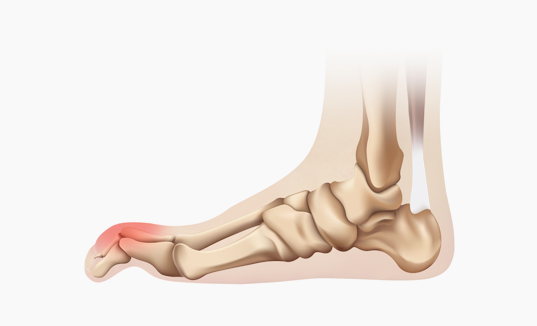Informacje o zabiegu
The most effective form of mallet toe treatment is surgery. It guarantees a quick return to painless walk. Thanks to it, we will prevent further callus, ingrown nail and subsequent irreversible arthritis. The surgeon proposes a procedure in case of failure of other conservative methods of treatment (e.g. change of footwear, applying fillers) and continuous development of deformation. The operation consists in incision of the skin and tissues located above the painful joint. It then removes the modified bone tissue and replaces it with an implant.
Wskazania
- surgeon proposes the treatment in case of failure of other conservative procedures (e.g. change of the footwear, applying fillers)
- constant development of deformation
- symptoms prevent normal functioning of the patient
Przeciwwskazania do zabiegu
- diseases related to coagulation disorders causing excessive bleeding, e.g. haemophilia
- immunosuppression through immunosuppressive drugs or HIV infection
- taking blood thinners
- advanced and uncontrolled diabetes
- active infections on the foot skin
- diseases causing ischaemia
- trophic lesions on the foot
- infection
- increased body temperature
- allergy to any anaesthetic drug
- surgery in case of young people with ununited metaphysis of metatarsal bones is contraindicated and requires special consultation with a doctor
Przebieg zabiegu
After anaesthetizing the patient by anesthesiologists, the surgeon incisions the skin and tissues above the affected joint; then removes the changed bone tissue from the epiphyses of the phalange and inserts the implant into its place. It is usually made of nickel and titanium. The inserted implant connects bone fragments, restoring the shape of toe.
Price:
3400 PLN
Korzyści z zabiegu
- improvement in appearance and aesthetics of the foot
- cushioning pain complaints
- improvement in the walk
- preventing further deformation of the joint
Zalecenia po zabiegu
- after treatment the patient for the first days should take care of the limb
- in case of pain, the analgesics recommended by the analgesic doctor may be taken
- the patient should regularly see the doctor for dressing changes, post-operative wound control and subsequent suture removal
- sometimes a rehabilitation is recommended
- appropriately selected by the qualified physiotherapist a set of exercises that will enable the faster recovery





